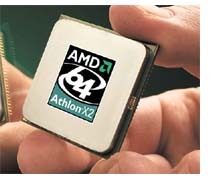AMD launches desktop dual-core processor Athlon 64 X2
Taipei - Creating a new opportunity for innovation in the computer industry, Intel and AMD almost simultaneously introduced their dual-core desktop processors for the mainstream market. The Athlon X2 follows on the heels of Intel's Pentium D and sets the benchmark for dual-core performance.
AMD challenges its rival with a complete series of dual-core chips. The initial line-up includes four models that differ in clock speed and size of the L2 cache. The entry-ticket into the dual-core family is the X2 4200+ (Manchester core), which is clocked at 2.2 GHz and offers 2 x 512 kByte L2 cache. One step up the ladder is the 4400+ (Toledo core) with the same clock speed, but 2 x 1024 kByte cache. Accordingly, the 4600+ and 4800+ are both clocked at 2.4 GHz and integrate 2x 512 kByte and 2 x 1024 kByte L2 cache.
The introduction of the X2 could be considered business as usual, since the competitive landscape typically dictates the launch dates of new processors. Today's introduction of the X2, however, is remarkable from several viewpoints and not just because of the fact that Computex opened its doors this morning and AMD got the chip out the door just in time.
Jonathan Seckler, senior product manager of AMD's microprocessor group, admitted that the chip is announced earlier than initially planned. According to Seckler, engineering went better than expected and accelerated the product schedule by three weeks with first X2's leaving the fabs on May 25. Also, Opteron yields were higher than AMD projected and allowed the X2 to move faster ahead. Seckler stressed Intel had no influence on the early introduction of the X2, but sources indicated that Intel's rolling marketing machine motivated AMD to get the X2 into stores as quickly as possible.
Being second may not be a disadvantage for AMD. As test results from Tom's Hardware Guide indicate, the X2 is clearly faster the Intel's Pentium D and is designed for a lower Thermal Design Power than the competition (110 watts compared to the Pentium D's 130 watts), providing system builders more flexibility to bring dual-core components and computers to the market. Also, the X2 slides simply into the Athlon 64's Socket 939 and offers an easy way to upgrade existing systems.
Buying a new computer with a single- or a dual-core processor is not an easy decision for consumers. Both Intel and AMD admit that dual-cores will not be their fastest processors for some time - at least as long as multi-threaded applications are not common. Intel uses an aggressive pricing structure to get consumers to buy dual-cores right away, while AMD is very well aware of its performance advantage and charges accordingly. Pricing for X2 processors begins at $537 - more than Intel's high-end Pentium D 840 ($530). The remaining X2s list for $581, $803 and $1001 - with the $4800+ being priced above Intel's dual-core Pentium Extreme Edition 840 ($999).
Asking for more than $1000 for the 4800+ is certainly a questionable move, but symbolizes AMD's confidence in this market. The company said these processors target "pro-sumers and creators" and not necessarily the mainstream user and gamer. "You have to use all the available power of the X2 to get value out of the dual-core," Seckler said. A 108 percent price premium over the single-core 4000+ ($482) will buy a 20 percent increase in application performance, Seckler said.
Get Tom's Hardware's best news and in-depth reviews, straight to your inbox.
While Intel appears not to be able to increase the clock speed of the Pentium D during this year, AMD says it has headroom left to scale the X2 into even higher regions. According to Seckler, an Athlon 64 X2 5000+ or 5200+ is "not out of the question."
Users looking for the best performing dual-core processor therefore are likely to check first AMD's X2 chip, even if the processor's price will dent the wallet. But industry experts believe that most users will stay with a single-core chip at this time - justifying Intel's apparently low production numbers of about 500,000 Pentium D's for this year. AMD did not say how many X2s will be shipped this year, but Seckler confirmed that "production capacity will meet demand."
In the end, limited consumer demand could be key for Intel to save its dominant position in the desktop processor market. Mainstream demand for dual-cores is not expected to pick up until 2006, which will buy Intel time to lower the Pentium D's power consumption and increase its performance. The chip's successor, the 65 nm part "Presler" (Pentium D 900-series), is on the roadmap for early 2006. Given AMD's current advantage, we would not be really surprised, if Intel accelerated the development of "Conroe" as well: Conroe will depart from the current Pentium's NetBurst architecture and is currently scheduled to debut in late 2006.
Related stories:
Intel launches Pentium D dual-core processor
AMD's Dual Core Athlon 64 X2 Strikes Hard

Wolfgang Gruener is an experienced professional in digital strategy and content, specializing in web strategy, content architecture, user experience, and applying AI in content operations within the insurtech industry. His previous roles include Director, Digital Strategy and Content Experience at American Eagle, Managing Editor at TG Daily, and contributing to publications like Tom's Guide and Tom's Hardware.
